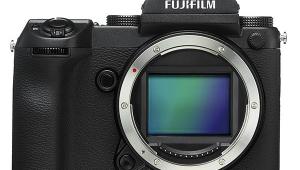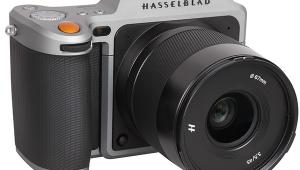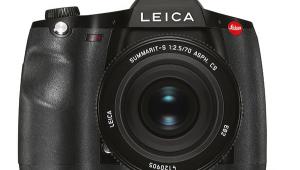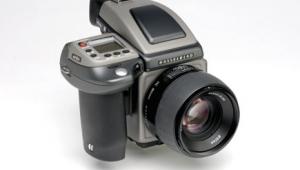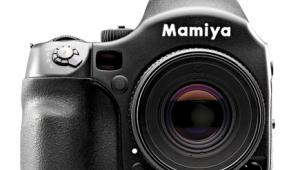Phase One XF 100MP Medium Format Camera Review

(Editor's Note: Lab Review lab tests and comments are supplied by BetterNet, Shutterbug’s TIPA-affiliated testing lab and edited by George Schaub. Shutterbug is the sole US representative within TIPA, a worldwide association of photo and imaging magazines.)
The Phase One XF 100MP is a medium format camera with extremely high sensor resolution. It is a modular concept comprised of the Phase One XF camera body, which was introduced in the summer of 2015, and the brand-new IQ3 100MP digital back. The body has a 90-degree prism viewfinder and includes a Schneider-Kreuznach 80mm LS f/2.8 lens. As expected, this does not come cheap: the total price for this kit is $48,990 USD, as of this writing, and is the most expensive camera system we’ve ever tested.
The Phase One XF 100MP offers a 53.7x40.4mm sensor with 11,608x8707 pixels, a total of 100MP. This is the highest sensor resolution of all digital cameras up to now. (Note: There are medium format cameras with higher image resolution: The Hasselblad H5D-200c MS with 200MP, for example, uses a multi-shot and pixel shift system to create 200MP images by interpolating/merging several 50MP images to a final high-resolution result. And of course there are prototype sensors/cameras like Canon’s 120MP system, which was shown a few months ago.)



Camera Build, Layout & Performance
Phase One’s XF camera is a very large and heavy system: a bit over three pounds with a 90-degree viewfinder and digital back, but without the lens. In combination with the 80mm lens (1.1 pounds) the photographer has to work with a system that has a weight of nearly four pounds. If the Schneider-Kreuznach 75-150mm LS f/4.0-5.6 lens is mounted, the weight is nearly seven pounds. This might seem like a very heavy load for those who shoot even with highly advanced pro DSLRs, but frankly we feel that medium format photographers are used to it.
Due to its modular system, the XF 100MP uses two rechargeable batteries. The first battery powers the body, the second the digital back. Nevertheless, the whole system will also work when using only one of them. Using both batteries, we did the technical test shots during a three-hour shooting session with many switch off/switch on processes when checking single test shots on the PC. For the model shots (one hour) we used freshly recharged batteries and took about 80 images. After that the batteries still had enough energy for an additional hour of shooting. Phase One supplies the camera with a recharger that can recharge both batteries at the same time. Our test sample was supplied with four rechargeable batteries.

The camera uses two touchscreens to set up all parameters. The status LCD on the top shows the same basic menu as the touchscreen on the IQ3 100MP digital back and allows the user to change exposure mode (P, S, A, M) via a fingertip control. The mirror lockup function can also be activated on the screen, but the camera offers an additional mode for shooting without any vibration. It uses a motion sensor (dubbed a “seismographic sensor”) to register and control even the finest vibrations. When using this mode and pressing the shutter release button the camera will detect these very fine vibrations and will wait until the camera is absolutely vibration free. After that it will start exposure of the image automatically. In this mode the mirror lockup function is automatically activated.
The Phase One XF uses a lot of function buttons on the top (near the status LCD) and on the back. In addition, it has three setup dials. The dial on the front is used to change shutter speed while the dial on the back of the grip is used to change aperture. The third dial (on the back, near the black function button) is used for menu setup. The functions of the buttons and dials are customizable. For example, the photographer can use the shutter release button to start autofocusing (pressing the shutter button halfway down) or he can use the function button on the back to start the AF system manually.
Compared to other medium format systems, the AF system of the XF 100MP is very fast, but can’t be compared to current AF systems of modern SLRs or CSCs. Compared to these cameras it is slower and doesn’t offer sophisticated focusing techniques like focus tracking of moving objects. Compared to the focusing system of the Phase One 645DF, however, the XF can be switched to a smaller area (dubbed “spot AF metering”). This can be used to focus on the eyes when shooting portraits. The camera supports “hyperfocal focusing” to choose the hyperfocal distance manually to maximize the depth of field. For manual focusing the camera offers a magnifier function on its live preview screen.
The camera shoots in Raw mode and doesn’t offer a JPEG option. The photographer can choose 14- or 16-bit Raw files for maximum image quality. As of this writing, the Raw files can’t be converted in Adobe Photoshop/Lightroom. The camera is supplied with Phase One’s Capture One Pro 9 software, which allows the user to convert and optimize images. It can also be used for tethered shooting. The digital back offers a FireWire 800 and a USB 3.0 interface for recording images directly on PC or Apple Macintosh operating systems.

Comments On Image Quality
Color: The Phase One XF 100MP camera records images with very natural and neutral colors. The Raw image of our test chart was converted with the “neutral” setting in Capture One Pro 9 and showed a result with nearly perfect saturation (99.4 percent) and a very neutral white balance. The gray patterns of the chart are located exactly in the center. Skin tones are a little bit optimized by a higher magenta rate by the converter software, but nearly all colors show only minor aberrations from their given values, with only the yellow elements showing a slightly larger variation. Colors in our standard test shots are nearly perfect. The skin tones shown in the portrait are very natural and nearly perfect. Color differentiation is on a very high level as well.
Sharpness: The camera created images with extremely high resolution. The test chart was reproduced with 8,645 of 8,708 lines per picture height and therefore 99.28 percent of its nominal sensor resolution. Even though resolution and sharpness are extremely high, the images have a very natural look. The sharpening effects are very low. We converted the Raw test images with the standard settings in Capture One Pro 9 and got images with only very minor over- and undershot effects. The overshot effect, for example, is 8.8 percent. In addition, the very high color differentiation supports the crisp and sharp look of the camera’s images. Fine details like the fabric of the model’s T-shirt are shown very clearly and are perfectly differentiated. There are absolutely no aliasing or moiré effects noticeable in our test shots. Even the extremely small figures in the two Siemens stars in the lower right of the standard test box images are readable.

Noise: The camera offers ISO speed settings from 50 to 12,800. In lower ISO speeds up to ISO 200, noise artifacts are nearly invisible. The noise spectrum is very smooth and the aberrations of RGB pixels are very low, so noticeable noise effects in the images are on a very, very low level. In images taken with ISO 800 or higher, noise artifacts get visible because the noise spectrum rises. The camera is designed to take properly illuminated images in the studio or when making landscape and nature images. It should be used with ISO 50 to 800/1600, but shouldn’t be used for documentary or available light photography with higher ISO speed settings. Reducing the 100MP resolution images to 24MP size, for example, will obviously reduce noise artifacts (size of noise artifacts).
The camera reproduced the test chart with 13.6 f/stops and even at higher ISO speed settings yielded more than 13 f/stops. Taking images of high-contrast scenes and using the “light” and “shadow” controls in Capture One Pro 9 shows details even in dark image areas that are underexposed or in totally blown-out highlights. This is breathtaking.
Note: The Phase One XF 100MP camera isn’t able to record video files, so for this test we don’t provide charts and captions concerning video tests.
Scorecard
Pros
› Sensor with very high resolution; very high-resolution results in test
› Extremely high dynamic range results
› Reliable and fast (for medium format) AF system
› Two touchscreens, three setup dials, and context-sensitive function buttons for easy setup
Cons
› Extremely expensive
› Shoots only Raw files (JPEG version for preview on the computer screen would be helpful)
› Complete camera system is very heavy and bulky
The Phase One XF 100MP has a list price of $48,990, which includes the Schneider-Kreuznach 80mm LS f/2.8 lens. For more information, visit phaseone.com.
(Lab Review is where we publish web-exclusive lab reports on cameras. To read more Lab Reviews, click on the Reviews tab on the top navigation bar of this page. New photo gear reports are published frequently, so check Reviews for more equipment evaluations from Shutterbug writers.)
- Log in or register to post comments


